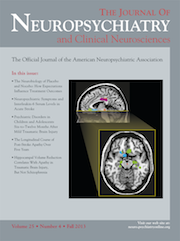Psychiatric Presentation of Sporadic Creutzfeldt-Jakob Disease: A Challenge to Current Diagnostic Criteria
Abstract
Pathological diagnosis remains the gold standard for the diagnosis of sporadic Creutzfeldt-Jakob disease (sCJD), but being able to differentiate between CJD and non-prion diseases clinically is important because many of the non-prion, rapidly progressive dementias are treatable. Diagnostic criteria need both high sensitivity and specificity while remaining applicable to clinical practice. Despite extensive updates to the clinical criteria for sCJD, there remains a heavy emphasis on neurological signs. We describe a psychiatric presentation of sCJD that did not fulfill the diagnostic criteria until very late in a prolonged disease course and required biopsy for diagnosis.



